Mary Magdalene
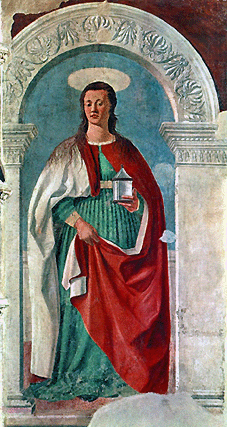 This interesting lady has not yet given up all her mysteries. Myriam Migdal Eder, the name she was given in the past, was born in the year 3 AD, according to professor Barbara Thiering. Her parents were the Jairuspriest Syrus and a princess from the royal Hosmonean house, Eucharia. When she was 14 years old, she became a priestess and member of an esoteric order. This is when she was given the name Myriam. She is best known for annointing Jesus with Nardus oil. She lived together with her sister Martha and her brother Lazarus or Simon of Cyrene. Both were perhaps not siblings but sister and brother in the esoteric order of Bethany, a place where Jesus would also often be seen. Bethany can be best discribed as a sort of Grandlodge of this mystical order and a hospital. The order was connected to the Essene order and has Egyptian/Indian roots.
This interesting lady has not yet given up all her mysteries. Myriam Migdal Eder, the name she was given in the past, was born in the year 3 AD, according to professor Barbara Thiering. Her parents were the Jairuspriest Syrus and a princess from the royal Hosmonean house, Eucharia. When she was 14 years old, she became a priestess and member of an esoteric order. This is when she was given the name Myriam. She is best known for annointing Jesus with Nardus oil. She lived together with her sister Martha and her brother Lazarus or Simon of Cyrene. Both were perhaps not siblings but sister and brother in the esoteric order of Bethany, a place where Jesus would also often be seen. Bethany can be best discribed as a sort of Grandlodge of this mystical order and a hospital. The order was connected to the Essene order and has Egyptian/Indian roots.In the first century, there were many religious groups. Several go back to the oldest religions and rituals. Many were connected to Egypt, India and Mesopotamia. All were connected by the belief in a Sun God and a Mother Goddess. This Mother Goddess has had many names depending on the area of worship: Artemis, Astarte, Ishtar, Isis... Her symbols were, among others, the water source or well, the eternal water of life, and the cave, symbol of the womb. The Mother Goddess was the center of existance. She took care of fertility, of life itself. The cult of Our Lady or Notre Dame is so old and so deeply rooted in the human mind, that it also had to be introduced in Christianity. And so, Mary, Jesus' mother, and also Mary Magdalene, who was Jesus' wife according to more and more scholars, became the first and most important women in the early days of Christianity, representing the Mother Goddess. In the early days, Jesus and Mary Magdalene were sometimes seen as the reincarnations of Isis and Osiris, the Egyptian god and goddess of life, life after death and fertility. The female aspect in the Middle-East was pushed aside partly by patriarchal Jewism. Jesus was one of the Holy Men in the Middle East who tried to repair the balance. This wasn't easy. For example, Peter was against women and even thought that they did not have the right to live. Myriam was, however, very intelligent, and Jesus' love and respect for her even caused jealousy among the disciples. One day Jesus said, "shall I then make her a man, so she is equal to us?"
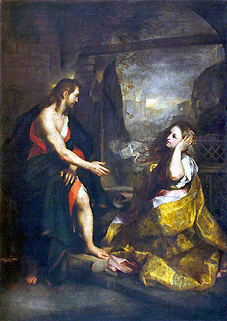 According to professor Barbara Thiering, Mary Magdalene was banished in the year 44, after an arrest which has been connected to a rise against the Roman rulers. She and her family and friends were put on a boat and ended up in France, on the Camarque coast. From there, roads parted and each group set out to spread their teachings. Whether Mary Magdalene was on board of that same ship is to be questioned. It is quite possible that she also came to France, on another ship, heading for the ancient port of Collioure, where there were fewer Romans than in Marceille or Narbonne.
According to professor Barbara Thiering, Mary Magdalene was banished in the year 44, after an arrest which has been connected to a rise against the Roman rulers. She and her family and friends were put on a boat and ended up in France, on the Camarque coast. From there, roads parted and each group set out to spread their teachings. Whether Mary Magdalene was on board of that same ship is to be questioned. It is quite possible that she also came to France, on another ship, heading for the ancient port of Collioure, where there were fewer Romans than in Marceille or Narbonne.The early Christians had quite an impact on the local people in southern France. The Notre Dame cult and Black Madonna cult soon became more and more popular. Hospitals were built where sick people or orphans were taken care of. Pregnant women were aided and the old were cared for, when no one else was there for them. Women were more or less equal to men in the Languedoc and compared to other places in Europe, this was quite unique. Some say that it was Mary Magdalene who built the religious gnostic foundation for the Cathars of southern France, who became a threat to the Catholic Church in the 12th and 13th centuries with their different views on Christianity. In this period, the Knights Templars florished. They had sworn an oath on the Lady of Sion and wanted to create their own state in the Languedoc. They did not lift a finger to harm the Cathars in any way and angered king and pope in doing so. With travelling to and from the Holy Land, the Knights Templar were largely responsible for the trade in relics, which were a rage in Europe as they were bought by churches as proof of the Biblical message and to draw pilgrims (and money) and last but not least, to spread Catholicism. Many places of pilgrimage were created in this process and large numbers of people went on such a pilgrimage, in an attempt to experience the divine. One of the most important places of pilgrim was Santiago de Compostela in northern-Spain.
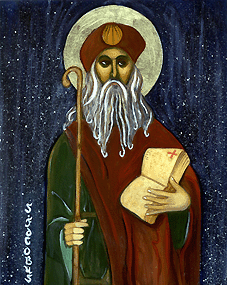 But who was Saint James? In the year 44, many things happened in Palestine. A schisma happened within the young Christian community. The land also experienced the seperation of two political groups: nationalists and the followers of the roman ruler Agrippa II. According to the story, the apostle James came back to Palestine after he had fulfilled his mission in Spain. However, as soon as he had arrived, he was arrested and beheaded. His friends smuggled his body out of Palestine and burried him in his beloved Spain. However, it is not certain which James was executed. It could have been another James, James of Zebedee. In that case, "our" James could have travelled back to Spain, where he died at a later date. There are many stories about James' return to Spain and the miracles he performed there. There is, however, enough proof that a certain James, disciple and according to historicus Robert Eisenman most probably the half brother of Jesus, was buried in Santiago de Compostela. In 813 his body was found where the famous cathedral now stands. From that moment onwards, stories about the miracles spread far and wide and thousands of pilgrims travelled the route de st. Jacques through France to Spain, from all countries in Europe.
But who was Saint James? In the year 44, many things happened in Palestine. A schisma happened within the young Christian community. The land also experienced the seperation of two political groups: nationalists and the followers of the roman ruler Agrippa II. According to the story, the apostle James came back to Palestine after he had fulfilled his mission in Spain. However, as soon as he had arrived, he was arrested and beheaded. His friends smuggled his body out of Palestine and burried him in his beloved Spain. However, it is not certain which James was executed. It could have been another James, James of Zebedee. In that case, "our" James could have travelled back to Spain, where he died at a later date. There are many stories about James' return to Spain and the miracles he performed there. There is, however, enough proof that a certain James, disciple and according to historicus Robert Eisenman most probably the half brother of Jesus, was buried in Santiago de Compostela. In 813 his body was found where the famous cathedral now stands. From that moment onwards, stories about the miracles spread far and wide and thousands of pilgrims travelled the route de st. Jacques through France to Spain, from all countries in Europe.And so, many churches and cathedrals arose on this famous route de st. Jacques, which were, in turn, given holy relics. And this is how Santiago de Compostela became the most important place of pilgrimage, after Jerusalem and Rome. It is on this route, that we find the church of Vezelay.

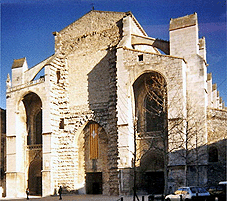 In Saint-Maximin-la-Sainte-Baume we find an even bigger gothic basilica dedicated to Mary Magdalene. She is supposed to have lived in a cave nearby, naked and only clothed by her long hair. Here we see the mix up of two different Mary's. According to the legend, Mary of Egypt was naked and had very long hair, with which she covered her body. She is not Mary Magdalene, but someone completely different. Because the Bible is not always clear on names and who is who, this mix up between several Mary's is no surprise. Perhaps the Magdalen was indeed a mix up of several different Mary's. Inside the basilica of Ste. Baum, a skull is venerated. It is a 2000 year old skull that belonged to a Mediterranean woman. Although this skull has been worshipped by the Church and several kings as the Magdalen's skull for many centuries, there is no proof that this really is her skull.
In Saint-Maximin-la-Sainte-Baume we find an even bigger gothic basilica dedicated to Mary Magdalene. She is supposed to have lived in a cave nearby, naked and only clothed by her long hair. Here we see the mix up of two different Mary's. According to the legend, Mary of Egypt was naked and had very long hair, with which she covered her body. She is not Mary Magdalene, but someone completely different. Because the Bible is not always clear on names and who is who, this mix up between several Mary's is no surprise. Perhaps the Magdalen was indeed a mix up of several different Mary's. Inside the basilica of Ste. Baum, a skull is venerated. It is a 2000 year old skull that belonged to a Mediterranean woman. Although this skull has been worshipped by the Church and several kings as the Magdalen's skull for many centuries, there is no proof that this really is her skull.
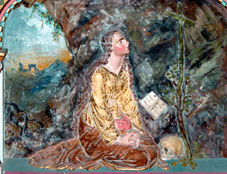 In these last few decades, and especially after the bestseller The Da Vinci Code, the little village of Rennes-le-Chateau has become a new place of pilgrimage for Mary Magdalene. New investigation suggests, that there is a possibility that Mary Magdalene was burried or reburried underneath the church of La Madeleine in Rennes-le-Chateau. Investigators are still researching this, but until 2015, no one is allowed to look into the crypt. This has been decided by the village council, after there had been a small hick-up with the Vatican during Robert Eisenman's investigations. This strange occurrance makes one wonder....
In these last few decades, and especially after the bestseller The Da Vinci Code, the little village of Rennes-le-Chateau has become a new place of pilgrimage for Mary Magdalene. New investigation suggests, that there is a possibility that Mary Magdalene was burried or reburried underneath the church of La Madeleine in Rennes-le-Chateau. Investigators are still researching this, but until 2015, no one is allowed to look into the crypt. This has been decided by the village council, after there had been a small hick-up with the Vatican during Robert Eisenman's investigations. This strange occurrance makes one wonder....
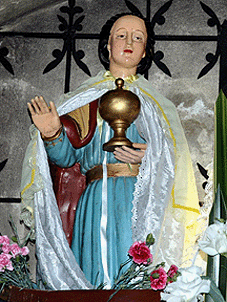 Les Saintes Maries de la Mer is the capital of the Camarque. This place has been named after the 2 Mary's (Mary Jacobe and Mary Salome) who, according to the original legend, were shipwrecked just off the coast of France and had lived on in southern France, bringing Christianity to Europe. According to the legend, the gypsy girl Sarah saw that the ship was in trouble and called for help. Thanks to this legend, Stes Maries de la Mer has become a holy place, where Biblical figures had supposedly stepped on French soil.
Les Saintes Maries de la Mer is the capital of the Camarque. This place has been named after the 2 Mary's (Mary Jacobe and Mary Salome) who, according to the original legend, were shipwrecked just off the coast of France and had lived on in southern France, bringing Christianity to Europe. According to the legend, the gypsy girl Sarah saw that the ship was in trouble and called for help. Thanks to this legend, Stes Maries de la Mer has become a holy place, where Biblical figures had supposedly stepped on French soil.  In the month of May, the statue of Ste. Sarah, who - according to the legend - had saved the Biblical saints on the night of the shipwreck, is taken from the church and brought to the sea to symbolically greet the saints. Some say Sarah was the daughter of Mary Magdalene, but that is only a recent myth and not part of the tradition. Also, Mary Martha and Mary Magdalene were later added to the story, probably to Christianize the heretical Provence by luring Catholic pilgrims to the newly created holy sites with their stories and relics. Because Ste. Sarah has become the patron saint of the gypsies, the locals celebrate an annual Gypsy Festival with music, dance and wonderful food.
In the month of May, the statue of Ste. Sarah, who - according to the legend - had saved the Biblical saints on the night of the shipwreck, is taken from the church and brought to the sea to symbolically greet the saints. Some say Sarah was the daughter of Mary Magdalene, but that is only a recent myth and not part of the tradition. Also, Mary Martha and Mary Magdalene were later added to the story, probably to Christianize the heretical Provence by luring Catholic pilgrims to the newly created holy sites with their stories and relics. Because Ste. Sarah has become the patron saint of the gypsies, the locals celebrate an annual Gypsy Festival with music, dance and wonderful food. Who Mary Magdalene really was, and which special task she was given by Jesus, we may never know. We do know that she was much more than the person we know from the Bible. She symbolises the female principle, which has been pushed aside ever since Christianity became patriarchal. The female counterpart of Jesus, who was very popular in France and still is, and who was not a reformed sinner, but an important disciple of Jesus, perhaps even his wife and true successor.
Read: "White Lie, the Quest for the Forbidden Relic", all about the secrets of Occitania, the Knights Templar, the Cathars, Rennes-le-Chateau and relic hunter Otto Rahn. More info: www.jeannedaout.com